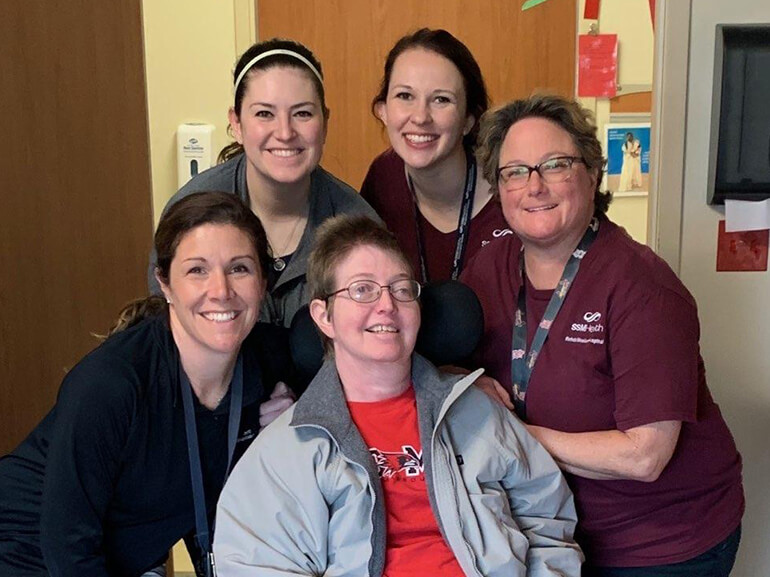Christine's story

It was November in O’Fallon, Illinois and Christine (Chris) Gass ordered pizza for her family. On her way to pick it up, her car was T-boned by a man driving through a stop sign. A nurse witnessed the accident and dialed 911. The nurse located Chris’s driver’s license at the scene and drove to her house to notify Chris’s husband, Ron, of the accident.
Air-lifted to the hospital, doctors diagnosed Chris with a severe brain injury, spleen laceration, broken collarbone and pelvis, as well as three broken ribs. Before the accident, Chris was a full-time paralegal and enjoyed hobbies such as watching TV, reading, working out and biking. She was very active prior to her accident, going to the gym every day to walk on the treadmill or lift weights.
Now, Chris was unable to stand, walk, speak, eat or perform everyday tasks like getting dressed or brushing her teeth. She was experiencing a disorder of consciousness, meaning that she was only partially “awake” or aware of her surroundings. She had respiratory failure and needed a tracheostomy to breathe. Chris remained in the hospital for two months before she was ready for rehabilitation. Her family chose SSM Health Rehabilitation Hospital – Bridgeton as the next step. “We visited other places, but reading the reviews here, especially for working with brain injuries, that did it,” Ron said.
When she first arrived at SSM Health Rehabilitation Hospital – Bridgeton, her therapy focused on simply trying to get her body to respond to various stimuli, like responding to taste by moving her tongue, or responding to sound. Once she became more responsive, therapy advanced to address speaking, swallowing, memory, mobility, self-care tasks and social interactions.
Shortly after admission, her tracheostomy tube was removed. Chris was initially unable to speak. In speech therapy, she began communicating by writing on a white board. Her husband Ron said once that occurred, she expressed herself clearly. Ron stated, “She answered everything. She wrote down all her siblings’ names, the numbers one through 10, the alphabet, everything. Once she was able to communicate, things started changing.” Chris’s speech therapist said her recovery was incredible. For weeks she was unable to make even a sound, then one day she was able to say ‘ah’ and the next day she was speaking in short sentences.
The focus in occupational therapy was to regain independence in her everyday life skills such as dressing and bathing. Because the severity of her injuries initially, Chris required full assistance for completion of even simple tasks. After working on skills such as sitting balance and functional use of her arms, Chris was able to participate in more meaningful tasks. Eventually, she could sit on the edge of the bed and assist with dressing. Day by day, she was able to assist in her everyday life skills with more independence.
In physical therapy, Chris could only walk 20 feet with two people holding her up. However, using the Lokomat®, a robotic body weight support system, she began moving through basic walking exercises, increasing walking distance and decreasing the need for help. After seven weeks, Chris progressed to walking with a cane with the help of one person. She also climbed three steps with the assistance of two people.
Chris, now able to speak, said family kept her motivated. “They’ve been great. They’ve played a big role.” Her husband Ron was involved in her recovery every step of the way and participated in family training. He was present for many sessions, keenly watching and listening to learn all he could. The therapists had full faith Chris would be in good hands when she was discharged. When asked what her goals were, she said “to talk, walk and dance at a wedding again.” She was pleased to have achieved two out of three of these goals during her stay.
After eight weeks, Chris went home with Ron and her two grown children. She left being able to complete some self-care activities independently, walking with assistance and communicating freely. She looked forward to getting back outside and exercising. She planned to start with home health assistance and then begin outpatient therapy at SSM Health Day Institute at Bridgeton to continue her recovery.
“Thank you so much to SSM Health Rehab Hospital,” said Ron. “Your team has made this bearable. I can’t thank you enough. I am starting to see a light at the end of this four-and-a-half month long tunnel.”